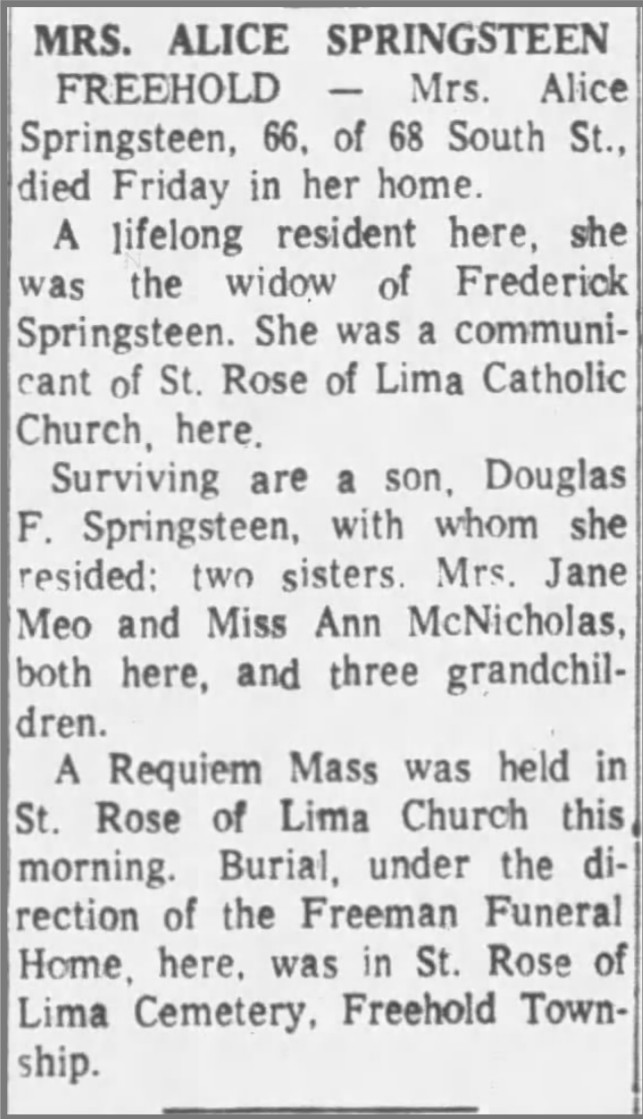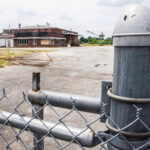Bruce Springsteen, the iconic voice of American rock, often weaves personal narratives into his music, drawing listeners into vivid worlds filled with raw emotion and relatable experiences. Long before he became “The Boss,” Springsteen was a young man shaped by his upbringing in Freehold, New Jersey, particularly by the home of his paternal grandparents at 87 Randolph Street. This formative place and the people within it left an indelible mark on his life and artistry, a fact poignantly revealed in his unreleased demo, “Randolph Street.”
This demo, recorded in the spring of 1972, offers a deeply intimate glimpse into Springsteen’s psyche, serving as both a therapeutic outlet and a loving tribute to his late grandparents, Fred and Alice Springsteen. “Randolph Street” stands apart from the more fantastical and character-driven songs he was composing at the time, such as “If I Was the Priest” and “It’s Hard to Be a Saint in the City,” both also recorded around the same period. Where those songs explored fictional narratives and larger-than-life personas, “Randolph Street” turns inward, focusing on the concrete reality of his childhood and the emotional landscape of loss.
The Enduring Significance of 87 Randolph Street
Springsteen’s autobiography, Born to Run, paints a vivid picture of his grandparents’ home on Randolph Street. He describes it as “decrepit,” heated only by a kerosene stove, and occupied by grandparents who, in his mature reflection, exhibited a lack of hygiene. Yet, despite these stark descriptions, Springsteen’s words resonate with profound affection and nostalgia. This seemingly contradictory sentiment is central to understanding the power of Randolph Street in his memory. It was a place of “ultimate security,” “full license,” and “unforgettable boundary-less love,” a sanctuary in the young artist’s life.
The lyrics of “Randolph Street” directly echo these sentiments, offering a raw and unfiltered look at his memories:
I remember yesterday
When I’d sit and watch the hound dogs play
Howling at the China moon
Now yesterday is the busted balloon
These opening lines immediately establish a sense of lost innocence. The metaphor of the “busted balloon” poignantly captures how quickly and irrevocably childhood joy can be shattered by the harsh realities of life. For Springsteen, the death of his grandmother in December 1965 was precisely such a moment, an event that, as he later wrote, made his “world collapsed.”
Life was young and things were easy
Days were short, nights were warm
Times were good, hate was shallow
Love was crazy and I had it in my marrow
I swear that I’ve seen your face
Somewhere back in that time and in that place
Do you remember?
This verse encapsulates the idyllic nature of childhood memories associated with Randolph Street. The simple pleasures, the warmth of love, and the deep-seated feeling of belonging are all evoked, tinged with a longing for a time and place now lost.
“Randolph Street”: A Portrait of Loved Ones
“Randolph Street” isn’t just about a place; it’s deeply intertwined with the people who inhabited it – his grandparents. The song offers stark yet tender portraits of Fred and Alice Springsteen:
The old house stood like World War II
With just two rooms and a hall to be used
The lady was lean, just slightly unclean
With a heart of cold silver and gold
The description of his grandmother as “slightly unclean” directly correlates with the autobiographical passage where Springsteen reflects on their poor hygiene. However, this observation is quickly juxtaposed with “a heart of cold silver and gold,” highlighting her inner strength and unwavering love, a complexity that transcends simple judgment.
The kitchen smelled of kerosene
The ceiling hung down unveiling rotted beams
And the man, they said his work it could’ve hung in the Louvre
But now he sits around all day because his left arm won’t move
He was a master of the art of electricity
He lectured on tubes and circuitry
He was self-employed, but he could never see
His way into the light
This verse paints a picture of his grandfather, the “radio man,” a man of skill and intellect diminished by circumstance. The “room full of switches and dials and lights” speaks to Fred Springsteen’s passion and expertise in electronics, while the line “but he could never see / His way into the light” hints at a life unfulfilled, perhaps reflecting economic struggles or personal limitations. Despite these hardships, the grandson remembers the comforting presence of his grandfather:
And when it got dark I could hear his heart beat
Like a mother in the night
This powerful simile reveals the depth of the young Bruce’s connection to his grandfather, portraying him as a source of comfort and security, a maternal figure in the darkness.
She stood like a guardian ready to give everything up
If I asked for a sword and her blood in a cup
But there was just a time when I asked for too much
She sighed because she could not give it
Alice Springsteen’s fierce devotion to her grandson is legendary in Springsteen lore. This verse captures that unwavering dedication, portraying her as a protective guardian willing to sacrifice anything for him. The “time when I asked for too much” is interpreted as the death of his grandfather, a loss that even her immense love could not remedy.
 Obituary clipping, likely resembling those that Bruce Springsteen might have seen, a stark reminder of loss and the passage of time.
Obituary clipping, likely resembling those that Bruce Springsteen might have seen, a stark reminder of loss and the passage of time.
Loss and the End of an Era at Randolph Street
The final verses of “Randolph Street” chronicle the passing of Springsteen’s grandparents and the profound impact of these losses on his young life.
We used to sit beneath the tree
Just the lady, the radio man, and me
And I think it was the winter of ’63
When the man went away and let us be
It was early on an August day
That the lady decided she too must go away
Her heart it seems could not pay
The price for what her body was buying
While Springsteen’s recollection of dates is slightly inaccurate (grandfather’s death in March ’62, grandmother’s in December ’65), the emotional truth remains potent. The imagery of the “lady” and “radio man” fading away marks the end of an era at Randolph Street, the close of a chapter in his childhood.
I come home from school and I found the note
I went into the kitchen and lit the old stove
With senses set on overload
I turned on the TVSpent the rest of the afternoon
Watching all my old cartoons
And through the hall and across the porch
As the sun surrendered like a crying torch
The poignant image of young Bruce returning home to find a note about his grandmother’s passing is followed by a powerful depiction of grief and shock. Seeking refuge in cartoons, he attempts to process the overwhelming loss, while the “sun surrendered like a crying torch” serves as a final, melancholic metaphor for the extinguished warmth and light that his grandmother brought into his life.
“Randolph Street”: A Timeless Reminder
“Randolph Street,” though never officially released or performed, stands as a testament to the enduring power of memory, family, and the places that shape us. It’s a deeply personal song that resonates with universal themes of love, loss, and the passage of time. Springsteen’s raw honesty and vulnerability in “Randolph Street” provide a powerful reminder to cherish our loved ones and the formative moments that define our lives. Every “busted balloon” and every extinguished “torch” leaves an indelible mark, shaping who we become. “Randolph Street” invites us to remember, to treasure, and to reflect on the profound impact of our own Randolph Streets and the people who made them home.
Randolph Street Recorded: April 1972 Never released Never performed
Looking for your favorite Bruce song? Check our full index. New entries every week!
Share this:
- Click to share on Twitter (Opens in new window)
- Click to share on Facebook (Opens in new window)
Like this:
Like Loading…

